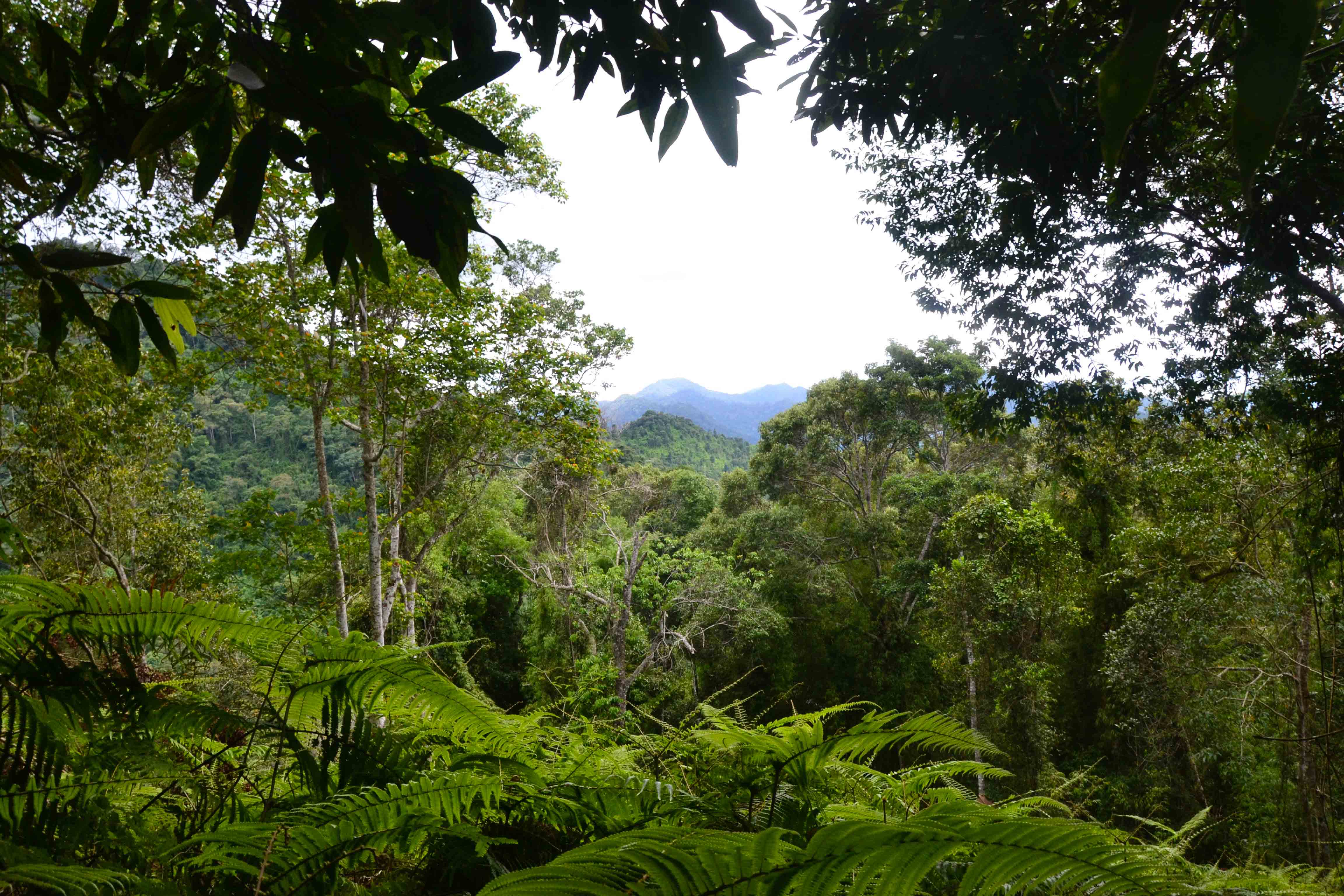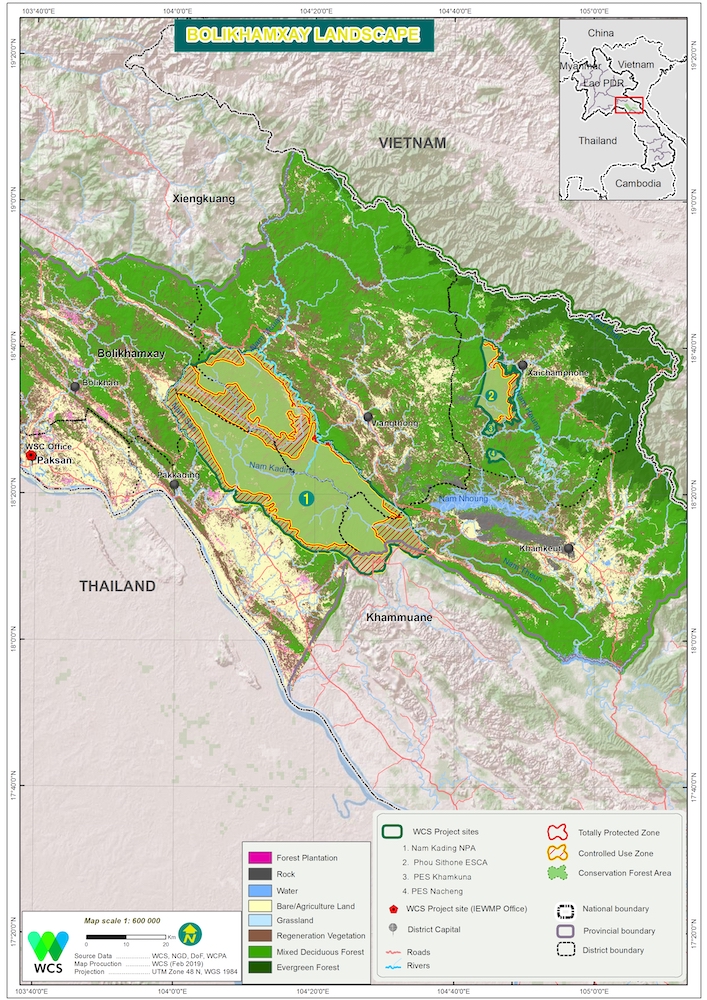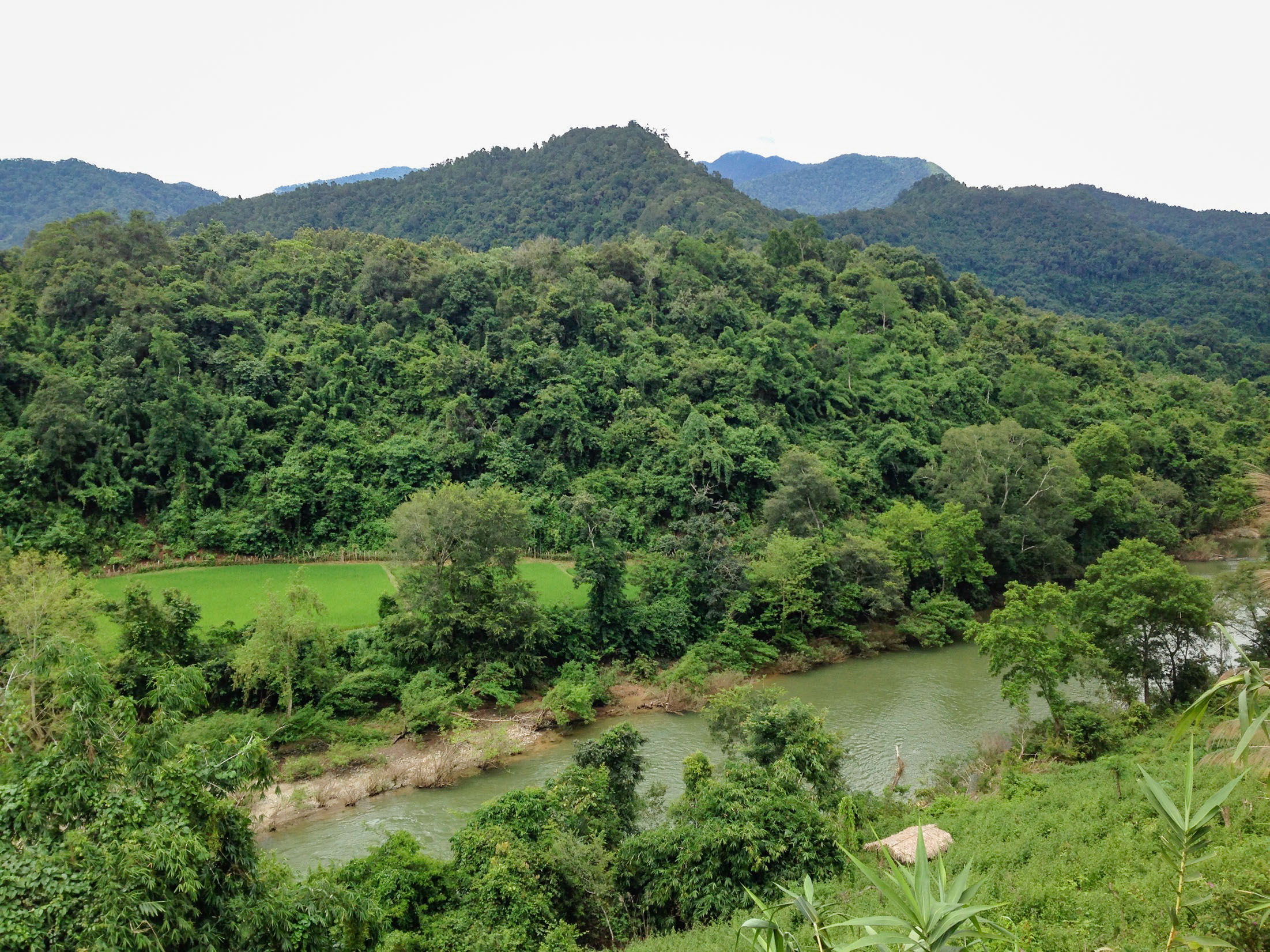Bolikhamxay (Lao: ບໍລິຄໍາໄຊProvince, situated in the center of the Lao PDR, is characterized by the Annamite Mountain Range stretching east to Vietnam, and the Mekong River and Thailand to the west.
The Annamite Mountains in the east are blanketed by semi- and wet evergreen forests and are home to a high number of endemic species. The western part of the province is largely covered by drier semi-evergreen forests of a type that is more widely distributed in Indochina and contains varied habitat including grasslands, wetlands, and limestone karst.
Recognized as a biodiversity hotspot by many international conservation assessments, and containing one of the largest blocks of dry evergreen (or semi-evergreen) forest in Indochina, the Bolikhamxay conservation landscape is of critical importance for the conservation of biodiversity due to the presence of a large number of endemic species and species of regional or global priority, such as
Saola, large-antlered muntjac, Asian elephant,
crested gibbon, Annamite striped-rabbit and three species of langur (red-shanked douc, Phayre’s langur and a sub species of Francois’s langur).
Within this landscape, the government of Lao PDR has declared several protected forest areas, the most important of which are the Nam Kading National Protected Area, the Phou Sithone Endangered Species Conservation Area, the Phou Chom Voy Provincial Protected Area, and the Nam Gnouang South Protection Forest Area.
While 58% of the province is covered by forests (in 2018), most of the protected areas are located in watersheds linked to hydropower projects.
The human population of Bolikhamxay is highly diverse, with several tribes from three major ethnic groups: Tai-Kadai, Khmuic that encompasses Khamu and Pong, and Hmong, totaling over 200,000 people. Population densities are, however, incredibly low with only 18 people/km
2. Around the protected areas in which WCS is involved (Nam Kading and Phou Sithone), community livelihoods rely on upland farming systems that are based on paddies, swidden agriculture, natural ecosystems and the services they offer, such as the provision of food, medicines, fuel, and non-timber forest products (NTFPs) that are both consumed and sold to help generate rural incomes.

Integrated Ecosystem and Wildlife Management Project (IEWMP)
WCS began working in the Bolikhamxay landscape in 2004, focusing on the Nam Kading Protected Area (169,000 ha). Initial activities concentrated on replicating the successful model of protected area management that WCS had developed for
Nam Et-Phou Louey (NEPL) in northern Laos. WCS extended its support to other protected areas, such as Nam Gnouang South Protection Forest in partnership with
Theun Hinboun Hydropower Company (THPC) (until the end of 2018), Phou Chomvoy Provincial Protected Area (until 2015) and Phou Sithone Endangered Species Conservation Area.
With the technical assistance of WCS, the provincial government began implementing a comprehensive project, the Integrated Ecosystem and Wildlife Management Project (IEWMP), with the overall goal to conserve and manage the forest resources and biodiversity within conservation forests, including Nam Kading National Protected Area, PAs and protection forests in support of improving local livelihoods sustainably.
THE FIVE KEY CORE CONCEPTS OF THE IEWMP ARE:
- Conservation planning and financing
- Capacity development and technical support
- Community engagement
- Biodiversity and watershed protection
- Research and monitoring

WCS interventions in Bolikhamxay
WCS intervenes in two main Protected Areas of Bolikhamxay and supports one initiative of “Payment for Ecosystem Services”:
1. Phou Sithone Endangered Species Conservation Area (14,136ha)
The PST ESCA is located in a very remote part of Xaychamphone district in the mountains of eastern Bolikhamxay Province and is designated as a provincial protected area. It was established by the government in 2010, principally with the support of WCS following the capture of Saola specimen. Eastern Bolikhamxay is a part of the Northern Annamites landscape, a CEPF Key Biodiversity Area.
The joint IEWMP implemented by WCS and the Provincial Authorities facilitated the creation and delineation of the Protected Area, developed and implemented local regulations, initiated enforcement operations, and developed an overall and comprehensive community engagement approach that links conservation to livelihoods development.
2. National Protected Area Management (169,000ha)
Nam Kading NPA was created in 1993. With few villages located inside the NPA and given the difficult access to the core area, the forests remained in fairly good state of conservation. In 2005, WCS began support to the Nam Kading NPA Management Unit, providing technical assistance, intensive biodiversity monitoring, outreach to communities, ecotourism training and law enforcement.
Nam Kading NPA is currently witnessing the development of the Nam Theun 1 hydropower project, increasing pressure over land for agriculture, and significant hunting related threats. Although large fauna such as Gaur, big cats, elephant, and
primates was present, it has disappeared or became scarce.
Since 2019, WCS and Provincial Authorities have been engaged in integrated management of the NPA, including revision of the management plan, spatial planning and land management, law enforcement and patrolling, capacity building of the personnel assigned, awareness campaigning and bodiversity monitoring.
The approach adopted is to support rural communities in and around Nam Kading NPA in developing their livelihoods through ecotourism, non-timber forest products, and village incentive funds.
Finally, WCS is facilitating the Public Private Partnership between the Theun Hinboun Hydropower Company and the Government to sustain long term financing mechanisms to the NPA.
3. Payment for Ecosystem Services (PES) Pilot
A pilot PES model was established with the community upstream of the THPC dam. Given the importance of the hydropower sector in Bolikhamxay Province, additional funding and tools are required to ensure communities can benefit from these developments. The initiative aims to tap users of services, such as the provision of freshwater for hydropower, to pay the communities who manage the ecosystems that deliver those services.
Two villages were selected in the catchment of Nam Gnouang dam operated by THPC to restore and conserve 1,870ha of lands. The overall goal of the management plans is to facilitate regeneration of forests and fallows through the reduction and, where appropriate, banning of activities such as logging, livestock raising, and swidden agriculture. Payments to communities, in exchange for the service, are substantial and provide additional incomes. Villagers decided to finance the improvement of water supply and revolving funds for cattle raising or handicraft for women's groups.
The objective of the initiative is then to scale this up and influence the development of national policy on PES.

Above: Phou Sithone National Protected Area
The WCS Mekong Drivers Partnership in Lao PDR as well as Cambodia and Myanmar brings together governments, communities, and the private sector at multiple scales to eliminate the threats that are driving the loss of biodiversity and habitat, and to protect the natural resources people depend upon.
Conservation Approach
This is an integrated approach to deliver conservation gains in high biodiversity landscapes such as Bolikhamxay, using the following strategies: